热门标签
热门文章
- 1邮箱投递简历注意哪些礼仪?
- 2STM32标准库FLASH读写_stm32 flash读写 库函数版
- 3程序媛的mac修炼手册-- 2024如何彻底卸载Python_mac系统如何清除python安装环境
- 4如何保证RabbitMQ消息的顺序性_rabbitmq如何保证消息的顺序性
- 5cuda9.1+torch0.4.0+torchvision.0.2.2+python3.6.x配置_wincuda9.1安装torch
- 6语言模型在新闻媒体中的应用
- 7Python数据可视化工具matpoltlib使用_python matpoltlab
- 8Pytorch-Lightning--v1.9中的训练器--Trainer
- 9必读!信息抽取(Information Extraction)【命名实体识别】_信息抽取作用
- 10flink NoSuchMethodException: org.apache.hadoop.hive.metastore.RetryingMetaStoreClient.getProxy
当前位置: article > 正文
【双目视觉】 SGBM算法应用(Python版)
作者:小丑西瓜9 | 2024-04-14 20:47:19
赞
踩
【双目视觉】 SGBM算法应用(Python版)
流程图
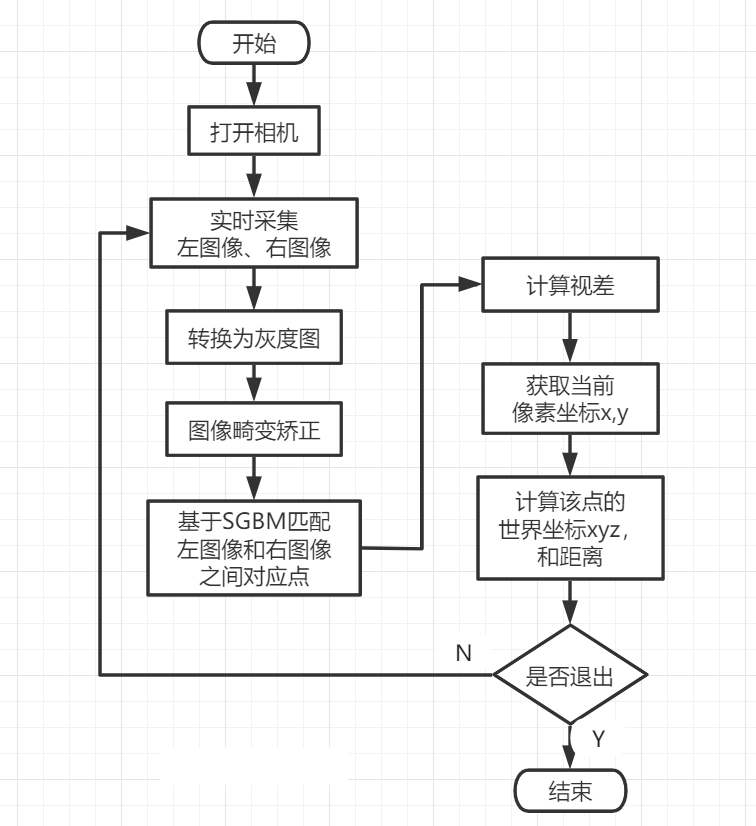
相机标定
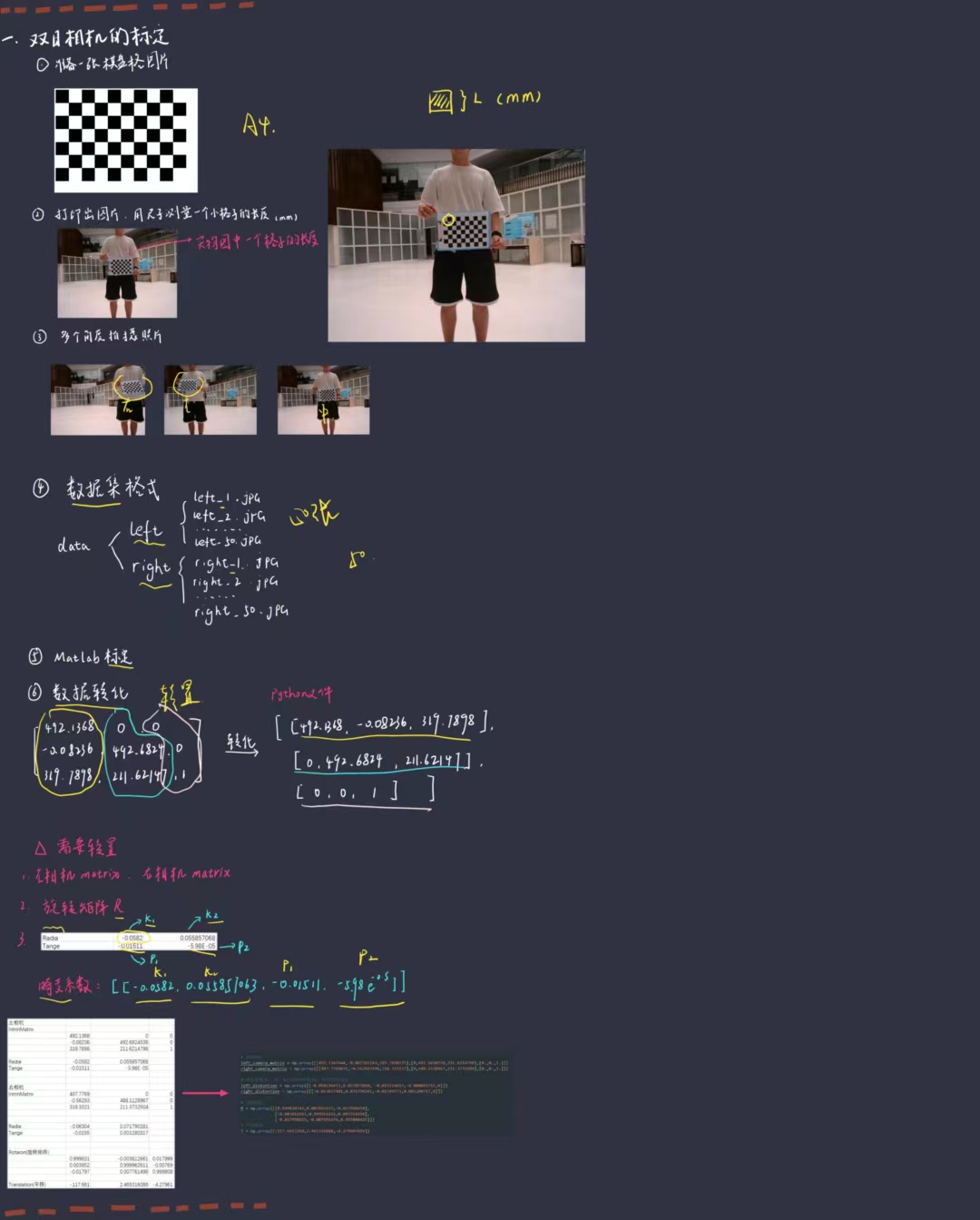
参考链接:【开源 |教程 | 双目测距】双目相机的标定_哔哩哔哩_bilibili
自制的标定数据集,必须用自己相机拍摄照片制作数据集
标定板下载:pattern.png (1830×1330) (opencv.org)
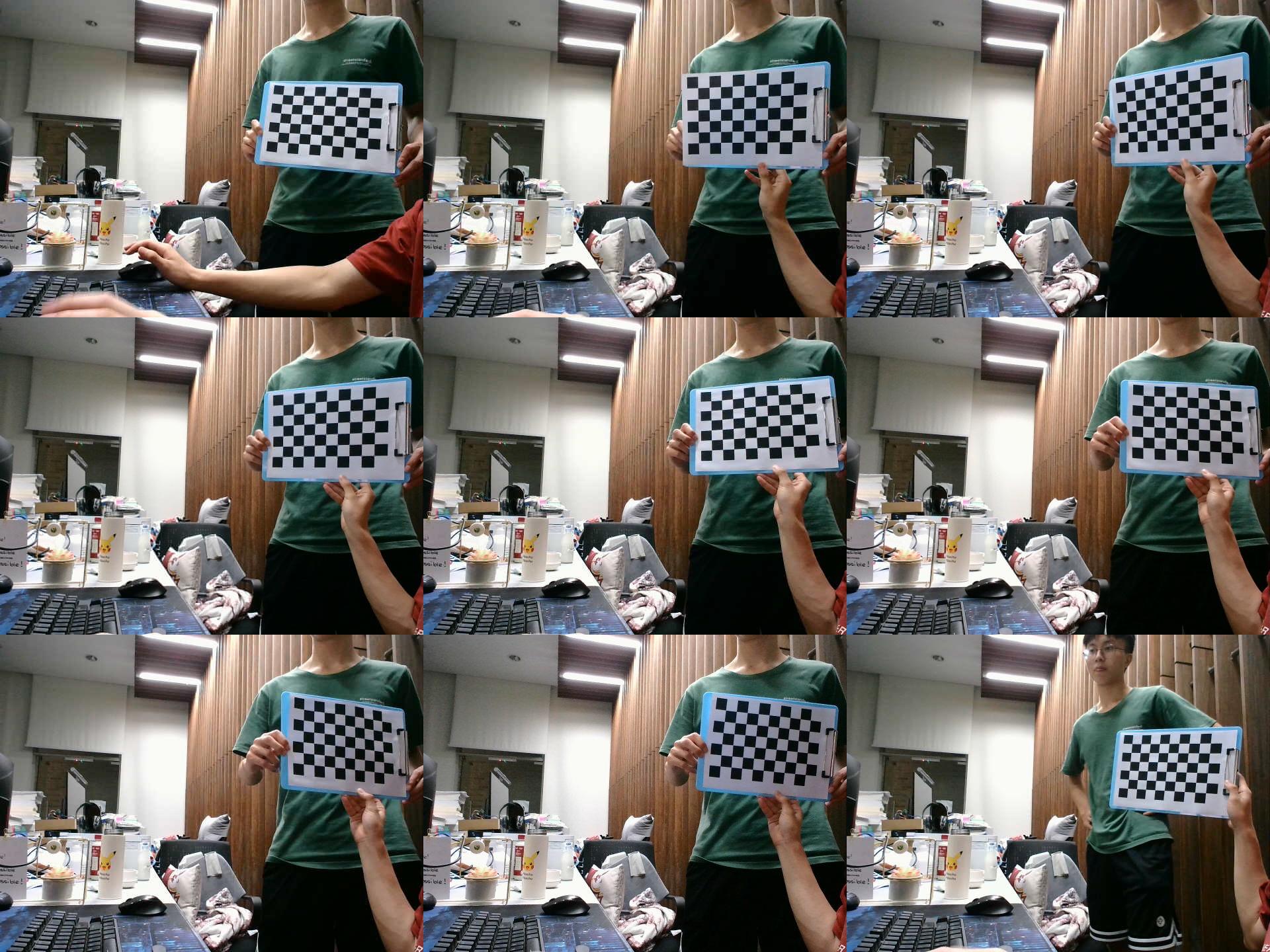
import cv2
import numpy as np
# -----------------------------------双目相机的基本参数---------------------------------------------------------
# left_camera_matrix 左相机的内参矩阵
# right_camera_matrix 右相机的内参矩阵
#
# left_distortion 左相机的畸变系数 格式(K1,K2,P1,P2,0)
# right_distortion 右相机的畸变系数
# -------------------------------------------------------------------------------------------------------------
# 左镜头的内参,如焦距
left_camera_matrix = np.array([[516.5066236,-1.444673028,320.2950423],[0,516.5816117,270.7881873],[0.,0.,1.]])
right_camera_matrix = np.array([[511.8428182,1.295112628,317.310253],[0,513.0748795,269.5885026],[0.,0.,1.]])
# 畸变系数,K1、K2、K3为径向畸变,P1、P2为切向畸变
left_distortion = np.array([[-0.046645194,0.077595167, 0.012476819,-0.000711358,0]])
right_distortion = np.array([[-0.061588946,0.122384376,0.011081232,-0.000750439,0]])
# 旋转矩阵
R = np.array([[0.999911333,-0.004351508,0.012585312],
[0.004184066,0.999902792,0.013300386],
[-0.012641965,-0.013246549,0.999832341]])
# 平移矩阵
T = np.array([-120.3559901,-0.188953775,-0.662073075])
size = (640, 480)
R1, R2, P1, P2, Q, validPixROI1, validPixROI2 = cv2.stereoRectify(left_camera_matrix, left_distortion,
right_camera_matrix, right_distortion, size, R,
T)
# 校正查找映射表,将原始图像和校正后的图像上的点一一对应起来
left_map1, left_map2 = cv2.initUndistortRectifyMap(left_camera_matrix, left_distortion, R1, P1, size, cv2.CV_16SC2)
right_map1, right_map2 = cv2.initUndistortRectifyMap(right_camera_matrix, right_distortion, R2, P2, size, cv2.CV_16SC2)
print(Q)
- 1
- 2
- 3
- 4
- 5
- 6
- 7
- 8
- 9
- 10
- 11
- 12
- 13
- 14
- 15
- 16
- 17
- 18
- 19
- 20
- 21
- 22
- 23
- 24
- 25
- 26
- 27
- 28
- 29
- 30
- 31
- 32
- 33
- 34
cv2.stereoRectify()函数
- 示例:
R1, R2, P1, P2, Q, validPixROI1, validPixROI2 = cv2.stereoRectify(left_camera_matrix, left_distortion,right_camera_matrix, right_distortion, size, R, T)- 作用:为每个摄像头计算立体校正的映射矩阵R1, R2, P1, P2
- 参数:
- left_camera_matrix:左相机内参
- left_distortion:左相机畸变系数
- right_camera_matrix:右相机内参
- right_distortion:右相机畸变系数
- size:单边相机的图片分辨率
- R:旋转矩阵
- T:平移矩阵
- 返回值:
- R1, R2:R1-输出矩阵,第一个摄像机的校正变换矩阵(旋转变换);R2-输出矩阵,第二个摄像机的校正变换矩阵(旋转变换)
- P1, P2:P1-输出矩阵,第一个摄像机在新坐标系下的投影矩阵;P2-输出矩阵,第二个摄像机在新坐标系下的投影矩阵
立体匹配
import numpy as np
import cv2
import random
import math
# 加载视频文件
capture = cv2.VideoCapture("./car.avi")
WIN_NAME = 'Deep disp'
cv2.namedWindow(WIN_NAME, cv2.WINDOW_AUTOSIZE)
# 读取视频
fps = 0.0
ret, frame = capture.read()
while ret:
# 开始计时
t1 = time.time()
# 是否读取到了帧,读取到了则为True
ret, frame = capture.read()
# 切割为左右两张图片
frame1 = frame[0:480, 0:640]
frame2 = frame[0:480, 640:1280]
# 将BGR格式转换成灰度图片,用于畸变矫正
imgL = cv2.cvtColor(frame1, cv2.COLOR_BGR2GRAY)
imgR = cv2.cvtColor(frame2, cv2.COLOR_BGR2GRAY)
# 重映射,就是把一幅图像中某位置的像素放置到另一个图片指定位置的过程。
# 依据MATLAB测量数据重建无畸变图片,输入图片要求为灰度图
img1_rectified = cv2.remap(imgL, left_map1, left_map2, cv2.INTER_LINEAR)
img2_rectified = cv2.remap(imgR, right_map1, right_map2, cv2.INTER_LINEAR)
# 转换为opencv的BGR格式
imageL = cv2.cvtColor(img1_rectified, cv2.COLOR_GRAY2BGR)
imageR = cv2.cvtColor(img2_rectified, cv2.COLOR_GRAY2BGR)
# ------------------------------------SGBM算法----------------------------------------------------------
# blockSize 深度图成块,blocksize越低,其深度图就越零碎,0<blockSize<10
# img_channels BGR图像的颜色通道,img_channels=3,不可更改
# numDisparities SGBM感知的范围,越大生成的精度越好,速度越慢,需要被16整除,如numDisparities
# 取16、32、48、64等
# mode sgbm算法选择模式,以速度由快到慢为:STEREO_SGBM_MODE_SGBM_3WAY、
# STEREO_SGBM_MODE_HH4、STEREO_SGBM_MODE_SGBM、STEREO_SGBM_MODE_HH。精度反之
# ------------------------------------------------------------------------------------------------------
blockSize = 8
img_channels = 3
stereo = cv2.StereoSGBM_create(minDisparity=1,
numDisparities=64,
blockSize=blockSize,
P1=8 * img_channels * blockSize * blockSize,
P2=32 * img_channels * blockSize * blockSize,
disp12MaxDiff=-1,
preFilterCap=1,
uniquenessRatio=10,
speckleWindowSize=100,
speckleRange=100,
mode=cv2.STEREO_SGBM_MODE_HH)
# 计算视差
disparity = stereo.compute(img1_rectified, img2_rectified)
# 归一化函数算法,生成深度图(灰度图)
disp = cv2.normalize(disparity, disparity, alpha=0, beta=255, norm_type=cv2.NORM_MINMAX, dtype=cv2.CV_8U)
# 生成深度图(颜色图)
dis_color = disparity
dis_color = cv2.normalize(dis_color, None, alpha=0, beta=255, norm_type=cv2.NORM_MINMAX, dtype=cv2.CV_8U)
dis_color = cv2.applyColorMap(dis_color, 2)
# 计算三维坐标数据值
threeD = cv2.reprojectImageTo3D(disparity, Q, handleMissingValues=True)
# 计算出的threeD,需要乘以16,才等于现实中的距离
threeD = threeD * 16
# 鼠标回调事件
cv2.setMouseCallback("depth", onmouse_pick_points, threeD)
#完成计时,计算帧率
fps = (fps + (1. / (time.time() - t1))) / 2
frame = cv2.putText(frame, "fps= %.2f" % (fps), (0, 40), cv2.FONT_HERSHEY_SIMPLEX, 1, (0, 255, 0), 2)
cv2.imshow("depth", dis_color)
cv2.imshow("left", frame1)
cv2.imshow(WIN_NAME, disp) # 显示深度图的双目画面
# 若键盘按下q则退出播放
if cv2.waitKey(20) & 0xff == ord('q'):
break
# 释放资源
capture.release()
# 关闭所有窗口
cv2.destroyAllWindows()
- 1
- 2
- 3
- 4
- 5
- 6
- 7
- 8
- 9
- 10
- 11
- 12
- 13
- 14
- 15
- 16
- 17
- 18
- 19
- 20
- 21
- 22
- 23
- 24
- 25
- 26
- 27
- 28
- 29
- 30
- 31
- 32
- 33
- 34
- 35
- 36
- 37
- 38
- 39
- 40
- 41
- 42
- 43
- 44
- 45
- 46
- 47
- 48
- 49
- 50
- 51
- 52
- 53
- 54
- 55
- 56
- 57
- 58
- 59
- 60
- 61
- 62
- 63
- 64
- 65
- 66
- 67
- 68
- 69
- 70
- 71
- 72
- 73
- 74
- 75
- 76
- 77
- 78
- 79
- 80
- 81
- 82
- 83
- 84
- 85
- 86
- 87
- 88
- 89
- 90
-
img1_rectified = cv2.remap(imgL, left_map1, left_map2, cv2.INTER_LINEAR):重映射,即把一幅图像内的像素点放置到另外一幅图像内的指定位置,俗称“拼接”我们可以通过cv.remap()函数来将img2映射到img1对应位置上并合成
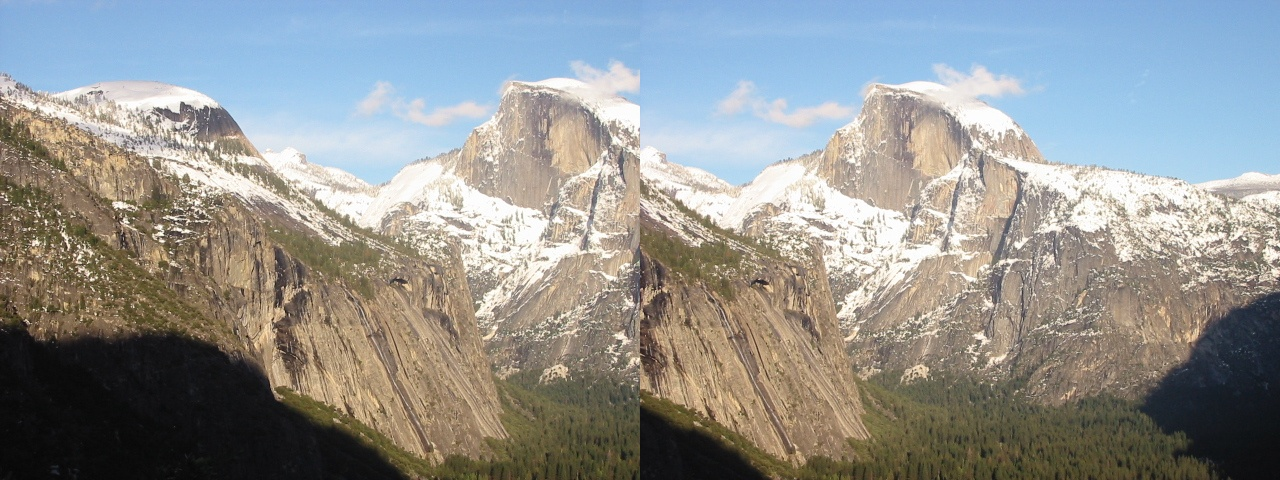
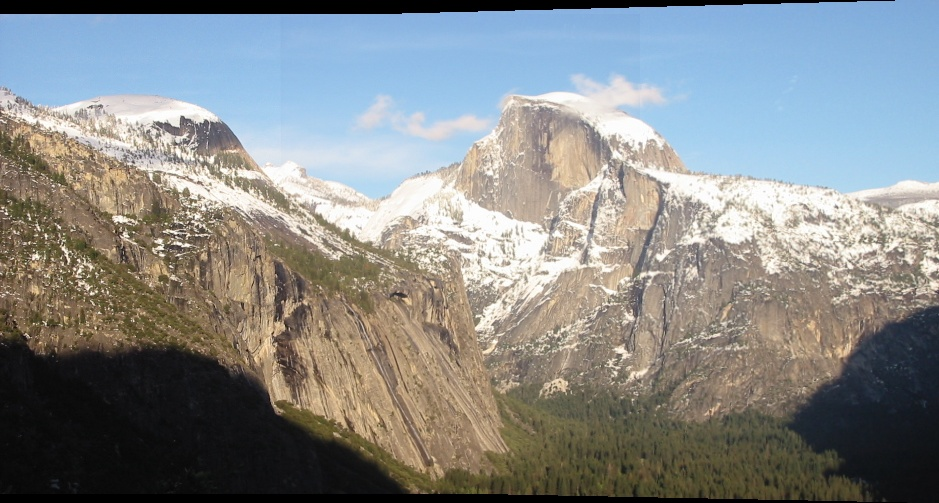
-
cv2.StereoSGBM_create()函数为opencv集成的算法;我们只需关注blockSize。 使用方法为: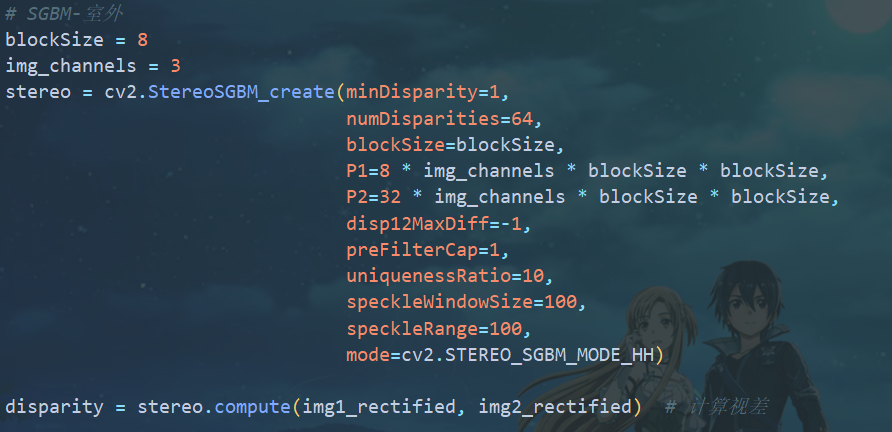
其中,调小
numDisparities会降低精度,但提高速度。注意:numDisparities需能被16整除mode可以设置为STEREO_SGBM_MODE_SGBM_3WAY,STEREO_SGBM_MODE_HH,STEREO_SGBM_MODE_SGBM,STEREO_SGBM_MODE_HH4四种模式,它们的精度和速度呈反比,可根据情况来选择不同的模式.STEREO_SGBM_MODE_HH4的速度最快,STEREO_SGBM_MODE_HH的精度最好
效果
1.原图像
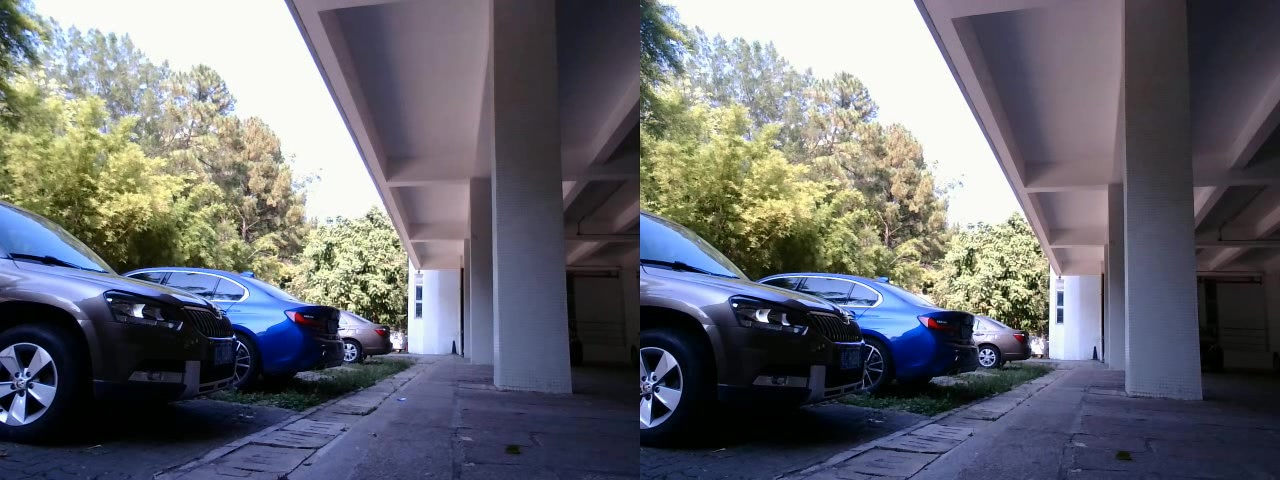
2.深度图
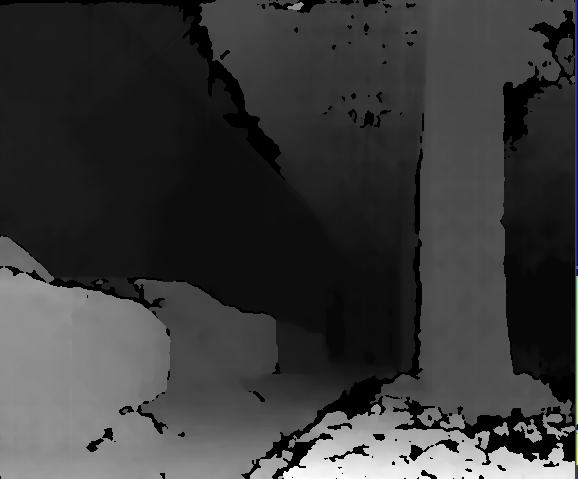

3.代码链接
https://github.com/yzfzzz/Stereo-Detection
声明:本文内容由网友自发贡献,不代表【wpsshop博客】立场,版权归原作者所有,本站不承担相应法律责任。如您发现有侵权的内容,请联系我们。转载请注明出处:https://www.wpsshop.cn/w/小丑西瓜9/article/detail/424032
推荐阅读
相关标签


